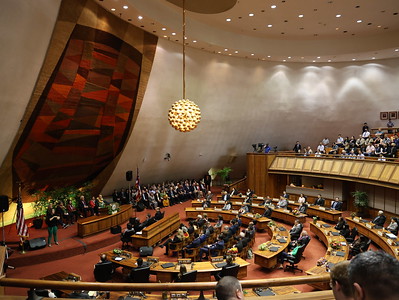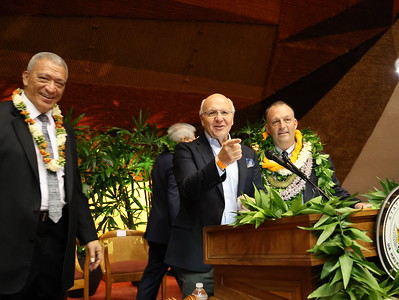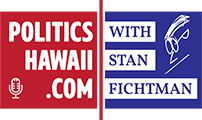
PC: Office of the Governor
On Monday, January 22nd, about a half-week after the start of the Legislative Session for the State of Hawaii, Governor Josh Green gave his second State of the State address.
Before the speech, Governor Green had already identified two key issues to emphasize – Housing and recovery from the wildfires in Lahaina.
These are the two most pressing issues for the people of Hawaii currently. As it stands, the issue of housing Lahaina wildfire victims and addressing the long-term needs of housing in Hawaii dovetail quite nicely and leverage each other for potential policy changes.
We will see.
However, the speech covered more than just the headlines or the main items highlighted by the media. And this is where it’s important for a politically savvy person to read the entire speech, all the way to the bottom.
In the section entitled “opportunities”, which is the second-to-last section in the script, Governor Green went and did an overall “covering the kitchen sink” list of subjects that he didn’t touch upon in the main speech. It is one of those items that piqued the interest of this humble blogger.
It had to do with this partial sentence in the last paragraph, “we opened high-level discussions with Japan to create an open travel corridor”. (It was his predecessor Governor Ige that started those talks…but we’ll say more about that later on).
“Hunh?” one may say, and ignore it because there is no context, but for the savvy, this idea entails a whole lot, with very key individual companies and entities in Hawaii getting plenty of benefits, should it come to pass.
Let’s explain.

PC: “Hawaiian party Alaska Airlines jet, smiling welcoming face of a Eskimo man from Barrow, American Flag, Seattle International Airport, SeaTac, Washington, USA” by Wonderlane is licensed under CC BY 2.0.
AN OPEN TRAVEL CORRIDOR between Japan and Hawaii is exactly that. If enacted it would be an agreement that would streamline travel between the two regions, aiming to ease current restrictions. Those restrictions include the traditional arrival procedures (immigration, customs, etc.) when entering Hawaii, which would be reciprocated in Japan.
So, in practicality, an open travel corridor would allow a traveler, who has all the proper paperwork to enter the United States, to get “Pre-Checked” in Japan by United States Customs and Immigration before they even board the plane.
The benefits become apparent when the plane lands in Honolulu (or other islands) where the passengers exit the plane as if they just flew a domestic (inside the United States) flight. They would not be subject to immigration or customs as it was already done at the departure point – Japan. This would allow the traveler, theoretically, to easily transit through Hawaii to a mainland destination, or exit the airport quickly after getting their baggage.
And this would not just be for American travelers returning, it would also be for Japanese nationals or anyone who had the proper paperwork in Japan going through Pre-Check. Vis a Vie, certain areas at Honolulu or Kona could potentially have an area where passengers would get Pre-Checked by Japanese immigration and customs before boarding the plane for Japan – again arriving as a domestic flight (theoretically) and not being delayed by immigration or customs control.
And those delays can be significant if you have been an international traveler coming to the United States, or a returning resident. For US Citizens, it takes about an hour to get through the process, with non-US citizens facing a potential 2 hours going through the process.
Take away that delay when arriving and one who knows can instantly see the benefits of doing all the process before in Japan, before getting on the plane.
And trust this blogger, if you can see it, both the Hawaii tourism industry and the State of Hawaii, who lives off the taxes from these trips, see the benefits of this too. Thus, the idea mentioned in the Governor’s speech.

PC: Office of the Governor
BUT WHO COULD IT ALSO BENEFIT? If one pays attention to the developments in Hawaii’s tourism and travel industries, an agreed-upon travel corridor could bring significant benefits.
The first one that could see a benefit is the airlines. More specifically our own Hawaiian Airlines is its entity. If the merger of Hawaiian with Alaska Airlines goes through, the benefits of having a streamlined arrival process for international flights become even more apparent. Not only would it eliminate delays for passengers, but it would also revive Honolulu’s potential as a transfer point after years of dormancy.
Before 9/11, Honolulu was used by some Asian airlines as a stopover point for their flights to and from the US Continent. At that time, international passengers whose destination was Los Angeles or San Francisco (for instance) who didn’t get off the plane or wanted to leave the airport, could easily continue to their next destination. Provided it was on the same flight, it still was a less burdensome way to travel.
After the 9/11 attacks, Homeland Security implemented new rules, which changed the benefit of being processed at your destination. Now if a plane lands in any airport from an international destination, all the passengers must exit the plane and go through customs and immigration. So for the passenger looking for less hassle, the idea of taking a flight that stopped in Hawaii didn’t make too much sense anymore unless they were coming to Hawaii itself.
And let’s face it, travelers sometimes want to see Hollywood or the Golden Gate Bridge more than Diamond Head and beaches.
Taking away that burden from travelers now could, theoretically allow a passenger who boarded a Hawaiian Airlines flight in, say, Tokyo bound for Honolulu, to get pre-checked in Tokyo and land in Honolulu at the Central Concourse. From there the traveler exits the Hawaiian flight and goes right over to the gate next door where an Alaska Air flight to, say, Bremerton, WA, is parked ready to board. The passenger gets on that flight and goes to Bremerton as if you or I were going.
Or they get off, spend three days in Waikiki, and then board the Bremerton, or any flight going to the Continent, and continue their United States trip. It could be that Alaska, in its matrix of reasons to buy Hawaiian, factored this in, but can only dream about it happening but can’t say it wants this in its SEC 8K filing.
But trust this blogger, they’ve been thinking about it.

PC: “Waiting more than 1 hour for United States Immigration control (JKF Airport – New York)” by scalleja is licensed under CC BY-SA 2.0.
BUT IT DOESN’T COME WITHOUT CHALLENGES. As with any good idea, implementation of something like this is not without its challenges, both legally and logistically. First off, a new Pre-Clearance agreement would need to be made between the United States and the Japanese Government. Japan has already identified, on its side, Hawaii as a place which it would be partial to creating a travel corridor, having named it as the only American destination for Japanese citizens to visit during the height of the COVID-19 saga.
The discussion about Hawaii being a safe place to travel during COVID-19 was initiated by Governor Green’s predecessor, David Ige. Green mentioned in his speech that this discussion has opened the door to high-level talks.
What Green has done, instead, is keeping the conversation going. The heavy lifting of advocating for Hawaii to be categorized as a safe place to travel was done by former Governor Ige. And if it wasn’t for COVID, the full roll-out of the travel corridor as described above most likely would have been implemented by now.
Now we got the record straight, let’s move on.
Then comes the practical questions of who pays for all of this, and whether the return on investment is worth the expense on both sides to implement. There probably is some modeling of this with the other nations that have Pre-Check facilities in their countries.
Then comes the Visa requirements of travelers using this system. Theoretically, an American Visa is an American Visa, but with the way our national administration in Washington, depending on who is the current resident of the White House, sees the world. travelers from different regions were seen differently than those from others. That is where voters come in on their choice on the matter.
When someone asks in Hawaiian Pidgin, “Can, no can?” the answer is a resounding “Can!” as long as the item remains a top priority for the Green and future administrations.
